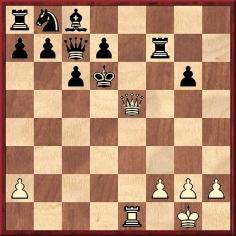
Edward Winter
Why would a world champion claim to have lost a 24-move brilliancy if such were not the case? That was a central question in our investigation into a famous game widely described as won by D. Janowsky and B. Soldatenkov against E. Lasker and J. Taubenhaus in Paris in 1909:
1 e4 e5 2 d4 exd4 3 c3 dxc3 4 Bc4 cxb2 5 Bxb2 Nf6 6 e5 Bb4+ 7 Nc3 Qe7 8 Ne2 Ne4 9 O-O Nxc3 10 Bxc3 Bxc3 11 Nxc3 O-O 12 Nd5 Qxe5 13 Re1 Qd6 14 Qh5 c6 15 Nc7 g6 16 Qh6 Qxc7 17 Bxf7+ Kxf7 18 Qxh7+ Kf6 19 Qh4+ Kg7 20 Re7+ Rf7 21 Qd4+ Kf8 22 Qh8+ Kxe7 23 Re1+ Kd6 24 Qe5 mate.

To mention just one standard source, the above players and occasion were given on page 171 of The Golden Treasury of Chess by Francis J. Wellmuth (Philadelphia, 1943). On page 66 of the second edition of Ouvertures du jeu d’échecs (Neuchâtel and Paris, 1929) Marc Nicolet presented it as an individual victory by Janowsky over Lasker, his source being specified as the Feuille d’Avis de Lausanne, 1927. However, the game had already appeared in the nineteenth century, won by Soldatenkov against S. Durnovo (or Durnowo). Below, for instance, is what was published on page 18 of Der Schachfreund, April 1898:

As noted in C.N. 1486, the game was also given as a win for Soldatenkov against Durnovo on page 504 of the November 1900 BCM, from České Listy Šachové. The latter source (April 1898 issue, page 55) is reproduced below courtesy of Karel Mokrý (Prostějov, Czech Republic):
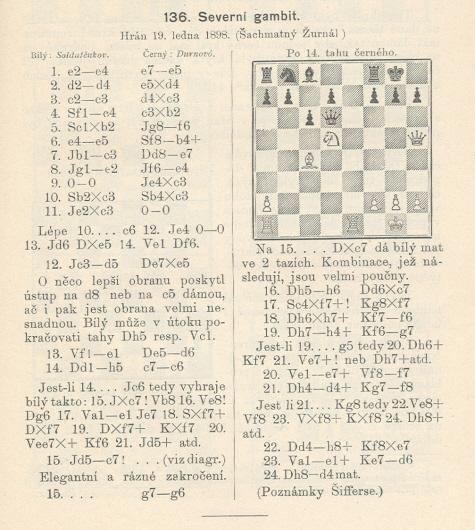
So did a consultation game in Paris simply repeat the moves of Soldatenkov v Durnovo? At first, that seemed possible, given that, as reported in C.N. 22, the following was presented on page 330 of the Illustrated London News, 27 February 1909:
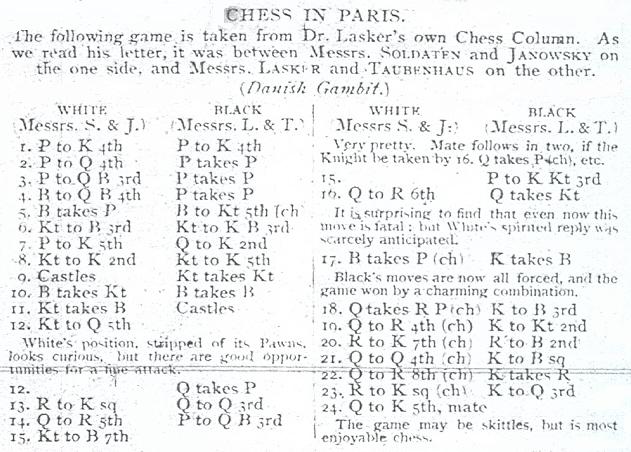
We asked whether Lasker really gave the game in his own column, and C.N. 774 quoted from page 162 of volume A of Walter Penn Shipley’s scrapbooks, which had a cutting, from an unidentified newspaper, undoubtedly written by Lasker:
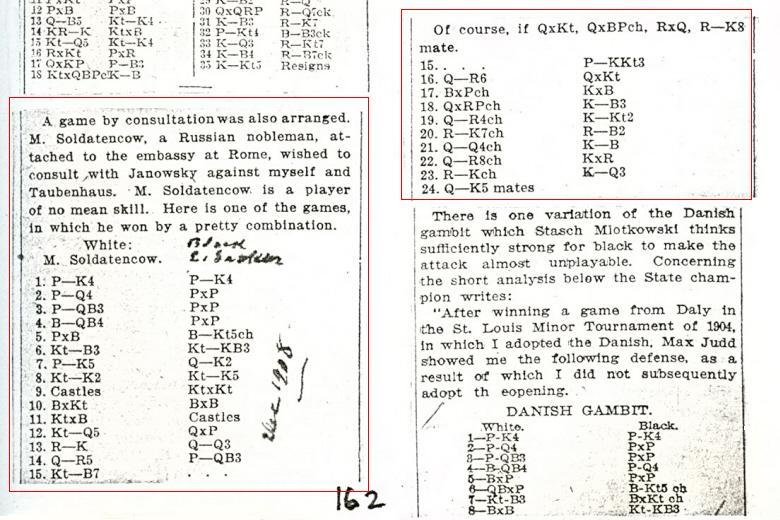
In that same item we commented on various points still requiring clarification:
‘a) The date. “1909” has always been given, but, if we are correctly reading a handwritten note in the scrapbook, the article in question by Lasker appeared on 2 December 1908.
b) The venue. Lasker does not specify Paris or anywhere else, at least not in the “clipped” clip preserved by Shipley.
c) The conditions. The Lasker quote above implies that “Soldatencow”, more than Janowsky, conducted the white pieces, and this is reinforced by the game heading, which does not mention Janowsky at all (or Lasker or Taubenhaus – only “Soldatencow”).
d) The source. Are we correct in guessing that the column is from the New York Evening Post of 2 December 1908?’
In C.N. 1369 there was further evidence to consider: the text below from page 878 of The Field, 22 May 1909:

After quoting this passage, which was also reproduced on page 260 of the June 1909 BCM, we commented:
‘In [C.N. 774] we wrote, “it would seem therefore that the ‘spurious’ game was indeed played”, but the above BCM-Field quote dents our confidence. If Janowsky and Soldatenkov had scored a win and a draw why would Janowsky have mentioned to The Field only the draw?’
In C.N. 1486 an additional complication was offered: the game appeared on page 77 of the March-April 1933 issue of Les Cahiers de l’Echiquier Français as Soldatenkov v Sabourow, St Petersburg, 1909. The magazine stated that the game’s attribution to Janowsky/Soldatenkov v Lasker/Taubenhaus was a frequent but inexplicable error. It has not been possible to ascertain on what basis the name Sabourow and the venue St Petersburg were introduced by the French magazine.
Then in C.N. 1574 a correspondent, Jack O’Keefe (Ann Arbor, MI, USA), shed considerable further light on the affair:
‘Lasker’s column in the “semi-weekly” edition of the New York Evening Post appeared on Thursday and Saturday; the Saturday column was repeated without change on the following Monday. Three columns have a bearing on the Soldatenkov “consultation game” versus Lasker.
The first, and most important, is the column of Saturday 30 January (and 1 February) 1909. Datelined “Paris, Jan. 5”, it deals with simuls by Lasker in Amsterdam, Utrecht, Groningen and Haarlem, and his subsequent trip to Paris. Lasker’s observations were not confined to the chess board:
“The women that one sees in the streets and restaurants are far from being pretty, with rare exceptions. But they dress with style, their conversation is lively, and they show an evident desire to please. Woman is the topic at all Parisian shows, which becomes a little monotonous after awhile.”
Lasker next describes a visit to the Café de la Régence, where a simul was arranged. Then comes the crucial paragraph:
“A game by consultation was also arranged. M. Soldatencow, a Russian nobleman, attached to the embassy at Rome, wished to consult with Janowsky and myself and Taubenhaus. M. Soldatencow is a player of no mean skill. Here is one of the games, in which he won by a pretty combination.
White
M. Soldatencow.”
The moves of the Danish Gambit game follow. Note that the reader is not told who played Black, 2) the date and place of the game, and 3) any consultation partner of Soldatenkov.
The column for Thursday, 4 February contains the game Lasker/Taubenhaus versus Janowsky/Soldatencow. It is a Ruy López, as given in Volume 3 of Whyld’s Emanuel Lasker, but without the repetition of moves on 18 and 19, and ending with 27 (29) PxKt and “After a few more moves the game was abandoned for adjudication, each side having queen and four pawns, with no evident advantage for either party”.Finally, in his column of 13 (and 15) February, Lasker says of the consultation team Janowsky/Soldatenkov: “One of their games was published in this column a few weeks ago.” [Emphasis mine.]
I believe that the evidence of these columns, combined with Janowsky’s failure to boast of a win over Lasker (as mentioned in C.N. 1369), proves that only one game – the Ruy López - was played between Lasker/Taubenhaus and Janowsky/Soldatenkov.
How did the misunderstanding arise? I suggest that it is a combination of 1) the poor typesetting at the head of the Danish Gambit game, which gave the reader no information except that Soldatenkov played White, 2) Lasker’s somewhat awkward phrasing (“Here is one of the games ...” instead of “Here is one of his games, in which he won by a pretty combination”, and 3) the failure of magazines that reprinted the game to heed the caveat of the Illustrated London News: “As we read his letter it was between Messrs Soldatenkov and Janowsky on the one side and Messrs Lasker and Taubenhaus on the other.” (C.N. 22). [Again, emphasis mine.]’
We believe that Mr O’Keefe analysed the matter impeccably. His contribution indicates that the cutting from Shipley’s scrapbook given above was indeed from Lasker’s New York Evening Post column. On the other hand, the handwritten note in the scrapbook still looks to us like ‘2 Dec. 1908’. If so, however, it must be an error since the Lasker/Taubenhaus v Janowsky/Soldatenkov consultation game which genuinely took place in Paris (the only one – a drawn Ruy López) was not played until 24 January 1909. The chronology suggests that during their time together in Paris Soldatenkov showed Lasker his old game against Durnovo, and Lasker published it in his Post column a week or so later. Although it was correctly reproduced on page 86 of the Chess Weekly, 6 February 1909, with the bare information that Soldatenkov was White, other writers were, as Mr O’Keefe remarked above, misled by Lasker’s poor presentation into thinking that the game also involved Lasker himself, Janowsky and Taubenhaus and had just been played in Paris.
Finally, in C.N. 2360 we pointed out that, as reported on page 110 of the 7 November 1909 Deutsche Schachblätter, Lasker subsequently denied involvement with the game, after Tarrasch had published the moves in Gartenlaube. [See also page 383 of the 31 October 1909 issue of Deutsches Wochenschach, as well as page 27 of the 20 January 1907 issue.]
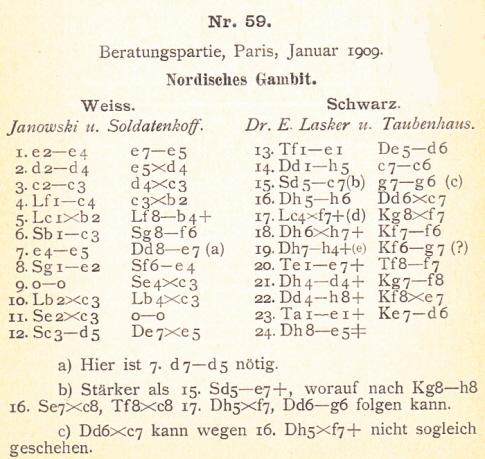
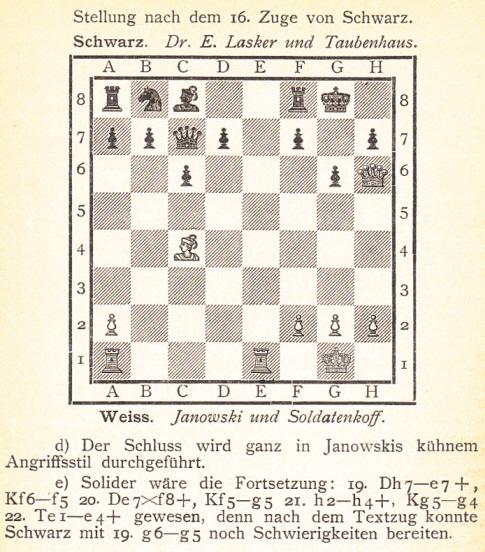
Source: Schachjahrbuch für 1909 by Ludwig Bachmann (Ansbach, 1909), pages 79-80. A correction on page 215 stated that the game did not involve Janowsky, Lasker and Taubenhaus:

(8551)
Patsy A. D’Eramo (North East, MD, USA) submits the chess column in The Times (London), 21 February 1898, page 14, which includes a pair of games:
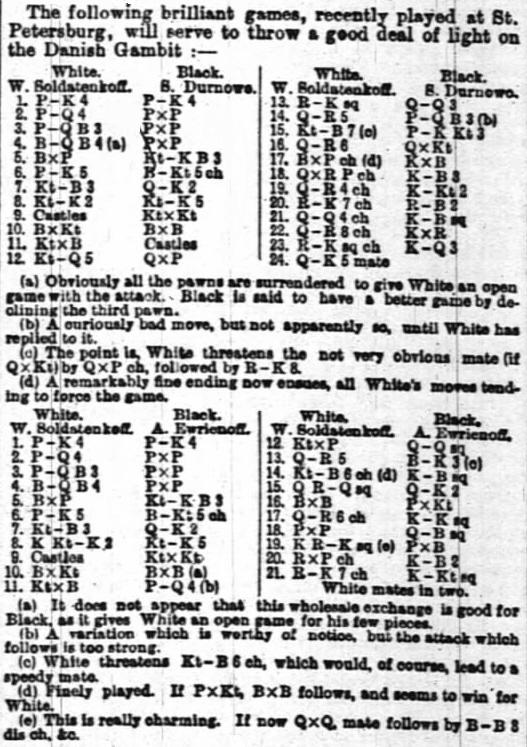
The second game (Soldatenkov v ‘Ewrienoff’) is also intriguing:
1 e4 e5 2 d4 exd4 3 c3 dxc3 4 Bc4 cxb2 5 Bxb2 Nf6 6 e5 Bb4+ 7 Nc3 Qe7 8 Ne2 Ne4 9 O-O Nxc3 10 Bxc3 Bxc3 11 Nxc3 d5 12 Nxd5 Qd8 13 Qh5 Be6
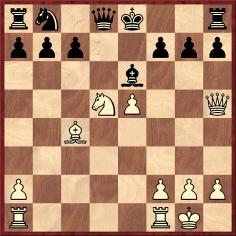
14 Nf6+ Kf8 15 Rad1 Qe7 16 Bxe6 gxf6 17 Qh6+ Ke8 18 exf6 Qf8
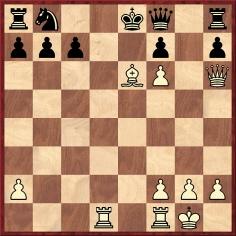
19 Rfe1 fxe6 20 Rxe6+ Kf7 21 Re7+ Kg8 and White mates in two.
(8557)
Dominique Thimognier (Fondettes, France) supplies the Lasker columns referred to above.
New York Evening Post, 30 January 1909, page 8:

New York Evening Post, 3 February 1909, page 5:

From Vitaliy Yurchenko (Uhta, Komi, Russian Federation) comes the publication of the Soldatenkov v Durnovo game in the Shakhmatny Zhurnal (Шахматный журнал), February 1898, pages 49-50. The periodical stated that the game was played on 19 January 1898:
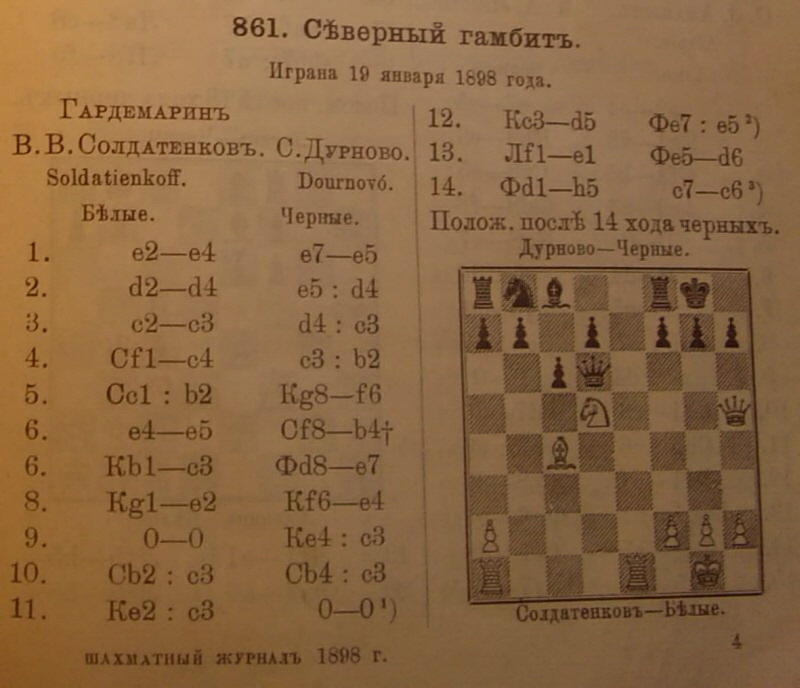
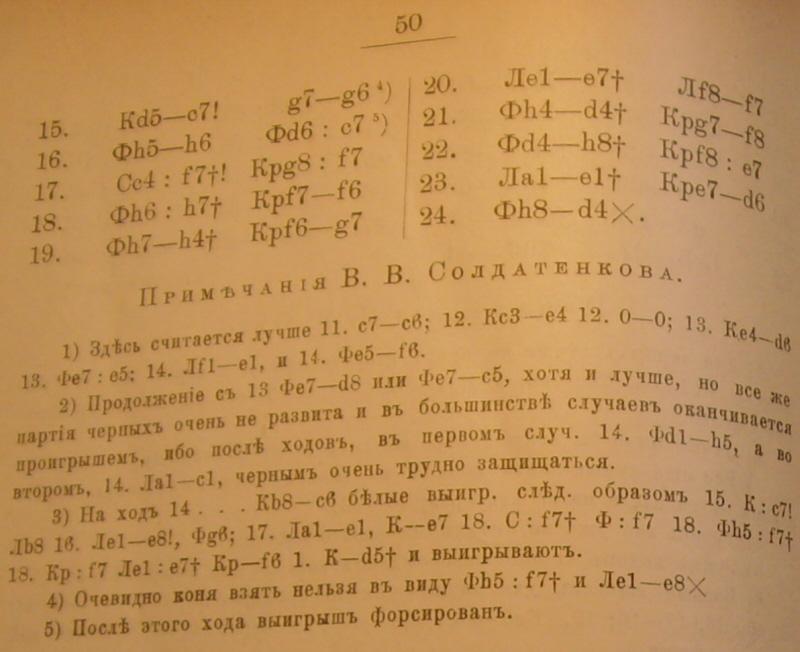
Although it has been known for decades that the Janowsky/Soldatenkov v Lasker/Taubenhaus consultation game (Danish Gambit) did not occur among these players, it receives three full pages (pages 148-150) in Chess for Rookies by Craig Pritchett (London, 2009). It is described as an ‘exhibition game’, and Lasker’s supposed partner is named as ‘Tabenhaus’.
(8840)
To the Chess Notes main page.
To the Archives for other feature articles.
Copyright: Edward Winter. All rights reserved.